Embark on a musical odyssey with our comprehensive piano keyboard chart, an indispensable guide for pianists of all levels. This interactive resource unveils the secrets of the piano’s layout, empowering you to navigate the black and white keys with confidence.
Dive into the world of note names and key signatures, unlocking the mysteries of major and minor scales. Discover the art of fingerings, playing techniques, and musical notation, transforming your piano playing into a harmonious symphony.
Our piano keyboard chart is not merely a static diagram; it’s a dynamic tool that adapts to your learning journey. With responsive HTML tables, you can explore the intricacies of the keyboard layout, note names, key signatures, and more, all at your fingertips.
Engage with interactive exercises and tutorials, making learning the piano an engaging and enjoyable experience.
Keyboard Layout
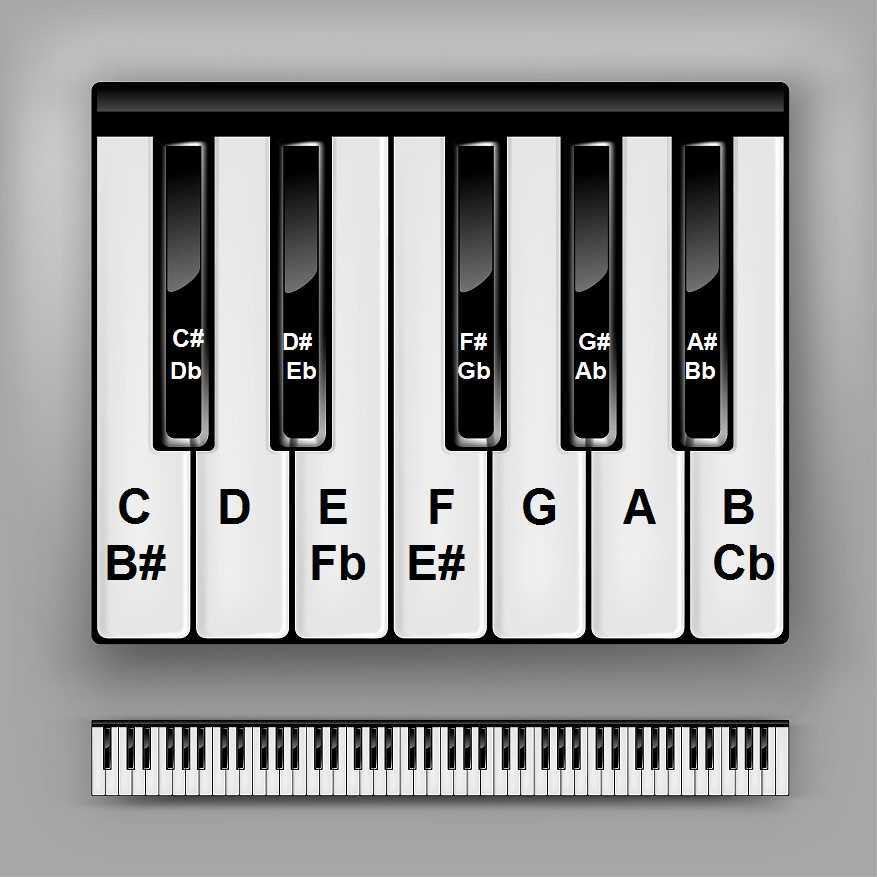
The piano keyboard consists of 88 keys, each representing a different musical note. The keys are arranged in a repeating pattern of seven white keys and five black keys. The white keys represent the natural notes (C, D, E, F, G, A, and B), while the black keys represent the sharps and flats (# and b).The
keyboard is divided into octaves, each consisting of 12 keys. The middle C key is located in the center of the keyboard and serves as the reference point for all other notes. The keys to the left of middle C are lower in pitch, while the keys to the right are higher in pitch.
| C | C# | D | D# | E | F | F# | G | G# | A | A# | B |
|---|
Note Names and Locations
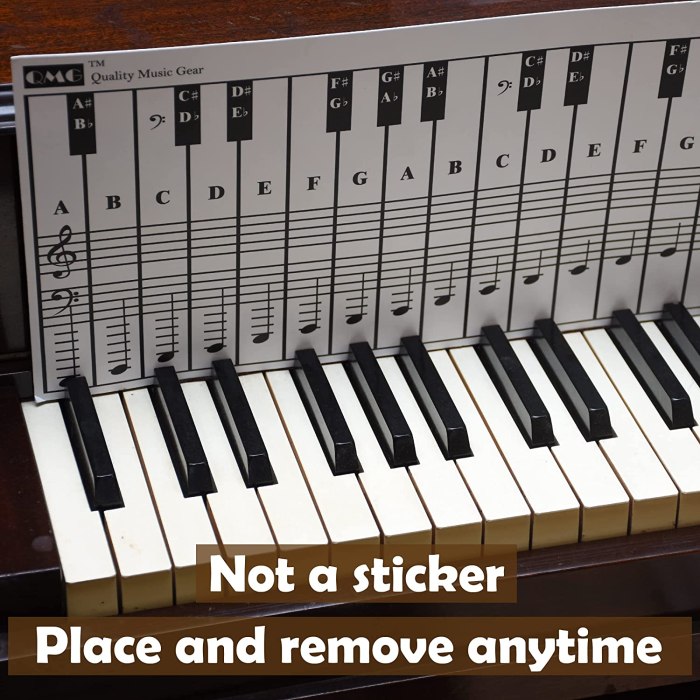
The piano keyboard is a fascinating layout of black and white keys that produce a wide range of musical notes. Understanding the naming conventions and locations of these notes is crucial for playing the piano effectively.
Each key on the piano is assigned a unique note name, following a specific pattern. The white keys represent the natural notes (C, D, E, F, G, A, B), while the black keys represent the sharps (#) and flats (b) of the adjacent white keys.
Key Position and Note Name Relationship
The position of a key on the keyboard directly corresponds to its note name. Starting from the leftmost white key, the notes progress in alphabetical order (C, D, E, F, G, A, B) as you move to the right.
The black keys are located between the white keys and are named according to their position relative to the adjacent white keys. For example, the black key to the right of C is named C#, while the black key to the left of D is named Db.
Note Name Mapping Table
The following table provides a comprehensive mapping of key positions to note names, including both white and black keys:
| Key Position | Note Name |
|---|---|
| Leftmost white key | C |
| White key to the right of C | D |
| Black key to the right of C | C# |
| White key to the right of D | E |
| Black key to the right of E | F |
| White key to the right of F | G |
| Black key to the right of G | G# |
| White key to the right of G# | A |
| Black key to the right of A | A# |
| White key to the right of A# | B |
Key Signatures
A key signature is a set of sharps or flats placed at the beginning of a musical staff. It indicates the key of the piece and determines which notes are played sharp or flat throughout the piece.
Common key signatures include:
- C major (no sharps or flats)
- G major (one sharp: F#)
- D major (two sharps: F# and C#)
- A major (three sharps: F#, C#, and G#)
- E major (four sharps: F#, C#, G#, and D#)
- B major (five sharps: F#, C#, G#, D#, and A#)
- F# major (six sharps: F#, C#, G#, D#, A#, and E#)
- C# major (seven sharps: F#, C#, G#, D#, A#, E#, and B#)
Similarly, key signatures with flats include:
- F major (one flat: Bb)
- Bb major (two flats: Bb and Eb)
- Eb major (three flats: Bb, Eb, and Ab)
- Ab major (four flats: Bb, Eb, Ab, and Db)
- Db major (five flats: Bb, Eb, Ab, Db, and Gb)
- Gb major (six flats: Bb, Eb, Ab, Db, Gb, and Cb)
- Cb major (seven flats: Bb, Eb, Ab, Db, Gb, Cb, and Fb)
| Key Signature | Sharps | Flats |
|---|---|---|
| C major | None | None |
| G major | F# | None |
| D major | F#, C# | None |
| A major | F#, C#, G# | None |
| E major | F#, C#, G#, D# | None |
| B major | F#, C#, G#, D#, A# | None |
| F# major | F#, C#, G#, D#, A#, E# | None |
| C# major | F#, C#, G#, D#, A#, E#, B# | None |
| F major | None | Bb |
| Bb major | None | Bb, Eb |
| Eb major | None | Bb, Eb, Ab |
| Ab major | None | Bb, Eb, Ab, Db |
| Db major | None | Bb, Eb, Ab, Db, Gb |
| Gb major | None | Bb, Eb, Ab, Db, Gb, Cb |
| Cb major | None | Bb, Eb, Ab, Db, Gb, Cb, Fb |
4. Major and Minor Scales
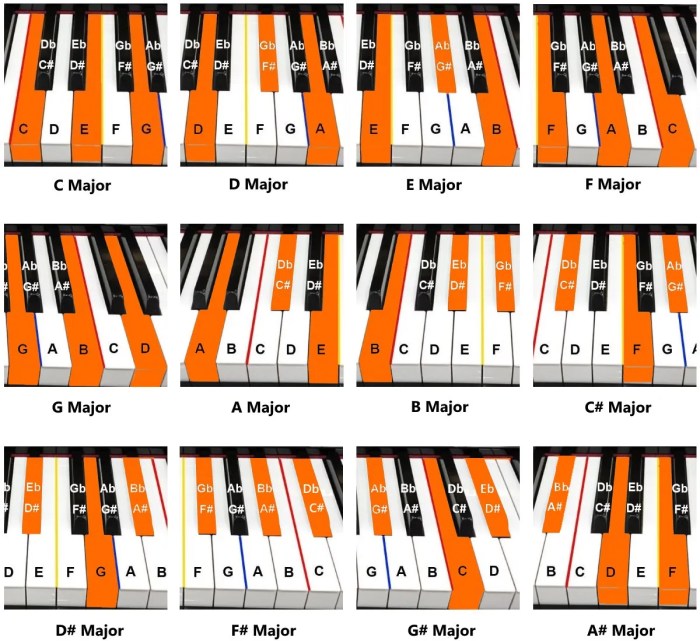
Major and minor scales are two of the most fundamental musical scales used in Western music. They are both seven-note scales, but they have different interval patterns, which give them their characteristic sounds.
Construction of Major and Minor Scales
A major scale is constructed by starting on a root note and then adding intervals of a whole step, whole step, half step, whole step, whole step, whole step, and half step. A minor scale is constructed by starting on a root note and then adding intervals of a whole step, half step, whole step, whole step, half step, whole step, and whole step.
Interval Patterns of Major and Minor Scales
The following table shows the interval patterns of major and minor scales:
| Scale | Interval Pattern |
|---|---|
| Major | W W H W W W H |
| Minor | W H W W H W W |
5. Chords and Arpeggios
Chords are groups of three or more notes played simultaneously, creating a harmonic sound. Arpeggios are chords played one note at a time, creating a melodic line. Both chords and arpeggios are essential elements of piano playing, providing a foundation for melodies and accompaniments.
Types of Chords and Arpeggios
There are numerous types of chords and arpeggios used in piano music. Some of the most common include:* Major chords : Consist of a root note, a major third, and a perfect fifth. They have a bright and cheerful sound.
Minor chords
Consist of a root note, a minor third, and a perfect fifth. They have a darker and more somber sound.
Seventh chords
Consist of a root note, a major or minor third, a perfect fifth, and a major or minor seventh. They add depth and complexity to harmonies.
Diminished chords
Consist of a root note, a minor third, a diminished fifth, and a minor seventh. They have a dissonant and tense sound.
Augmented chords
Consist of a root note, a major third, and an augmented fifth. They have a bright and intense sound.
Table of Common Chords and Arpeggios
The following table lists some of the most common chords and arpeggios and their corresponding notes:| Chord/Arpeggio | Notes ||—|—|| C major | C, E, G || C minor | C, Eb, G || C major seventh | C, E, G, B || C minor seventh | C, Eb, G, Bb || C diminished | C, Eb, Gb || C augmented | C, E, G# |
Fingerings

Proper fingering technique is essential for developing efficient and accurate piano playing. It involves using the optimal finger placement for different scales and chords, which allows for smooth transitions and minimizes hand strain.
For scales, the general rule is to use consecutive fingers (1, 2, 3, 4, 5) for ascending and reversed order (5, 4, 3, 2, 1) for descending. For example, in the C major scale, the fingering for the ascending right hand would be 1-2-3-1-2-3-4-5.
For chords, the fingering depends on the chord type and inversion. Common chord fingerings include:
Triads
- Root position: 1-3-5
- First inversion: 2-4-5
- Second inversion: 3-4-5
Seventh chords
- Root position: 1-3-5-7
- First inversion: 2-4-5-7
- Second inversion: 3-4-5-7
- Third inversion: 4-5-6-7
| Scale | Ascending | Descending |
|---|---|---|
| C Major | 1-2-3-1-2-3-4-5 | 5-4-3-2-1-2-3-1 |
| G Major | 1-2-3-1-2-3-4-5 | 5-4-3-2-1-2-3-1 |
| D Major | 1-2-3-1-2-3-4-5 | 5-4-3-2-1-2-3-1 |
| A Minor | 1-2-3-1-2-3-4-5 | 5-4-3-2-1-2-3-1 |
| E Minor | 1-2-3-1-2-3-4-5 | 5-4-3-2-1-2-3-1 |
| B Minor | 1-2-3-1-2-3-4-5 | 5-4-3-2-1-2-3-1 |
Playing Techniques
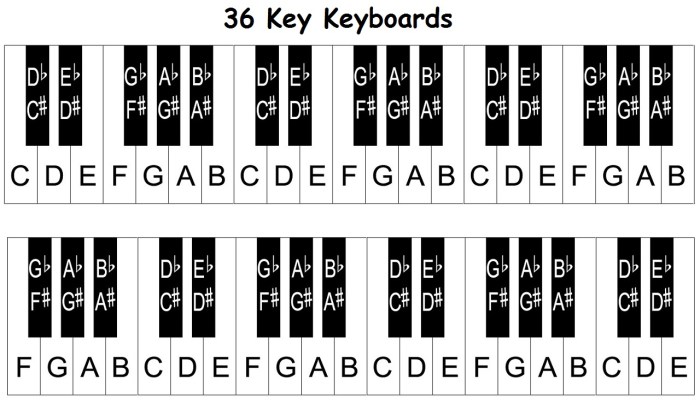
Piano playing techniques encompass a diverse range of methods employed to create distinct musical effects. Mastering these techniques enhances expressiveness and control over the instrument.
Various playing techniques can be broadly categorized into legato, staccato, and trills, each with unique characteristics and applications.
Legato
Legato, meaning “smoothly connected,” involves playing notes in a seamless manner without any noticeable gaps or breaks between them. The key is pressed down and held until the subsequent note is played, resulting in a fluid and lyrical sound. This technique is often used in classical music to convey emotions such as grace and tenderness.
Staccato
In contrast to legato, staccato denotes a detached or separated playing style. Notes are played with a quick, percussive touch, with a brief pause or gap between each note. This technique creates a crisp and rhythmic effect, often employed in lively or energetic passages.
Staccato is commonly used in jazz, ragtime, and popular music.
Trills
Trills involve rapidly alternating between two adjacent notes, creating a shimmering or vibrating effect. The trill can be performed with a single finger or with both hands, and its speed and duration can vary depending on the musical context. Trills add ornamentation and excitement to a piece, often used in Baroque and Classical music.
Table: Piano Playing Techniques
| Technique | Description | Effect | Applications |
|---|---|---|---|
| Legato | Smoothly connected notes | Fluid, lyrical | Classical music, expressing grace and tenderness |
| Staccato | Detached, percussive notes | Crisp, rhythmic | Jazz, ragtime, popular music |
| Trills | Rapid alternation between adjacent notes | Shimmering, vibrating | Baroque, Classical music, ornamentation and excitement |
Musical Notation

Musical notation is a system of symbols used to represent musical sounds and their organization in time. It allows musicians to communicate musical ideas with precision and accuracy.For the piano, musical notation is typically written on a staff, which consists of five horizontal lines and four spaces.
Notes are placed on the lines and spaces to indicate their pitch. The pitch of a note is determined by its position on the staff, with lower notes being placed lower on the staff and higher notes being placed higher.In
addition to notes, musical notation also includes symbols to represent rhythms, dynamics, and other musical elements. These symbols are placed above or below the staff to indicate how the music should be played.
Symbols for Notes
The following table shows the symbols used to represent different notes on the piano:| Note | Symbol ||—|—|| C | || D | || E | || F | || G | || A | || B | |
Symbols for Rhythms
The following table shows the symbols used to represent different rhythms on the piano:| Rhythm | Symbol ||—|—|| Whole note | || Half note | || Quarter note | || Eighth note | || Sixteenth note | |
Other Musical Symbols
In addition to notes and rhythms, musical notation also includes a variety of other symbols to represent different musical elements. These symbols include:*
-*Clefs
Clefs are symbols that indicate the pitch range of the music. The treble clef is used for higher-pitched music, while the bass clef is used for lower-pitched music.
-
-*Time signatures
Time signatures indicate the number of beats in a measure and the type of note that receives one beat. For example, a time signature of 4/4 indicates that there are four beats in a measure and that each quarter note receives one beat.
-*Key signatures
Key signatures indicate the key of the music. The key of a piece of music determines which notes are used and which scales are used.
-*Accidentals
Accidentals are symbols that indicate that a note should be played sharp or flat. A sharp sign (#) indicates that a note should be played one half step higher than its normal pitch, while a flat sign (b) indicates that a note should be played one half step lower than its normal pitch.
Piano Care and Maintenance
Regular care and maintenance are essential to preserve the quality and performance of a piano. By following a few simple steps, you can keep your piano in optimal condition for years to come.
Importance of Piano Maintenance
A well-maintained piano will hold its value, play better, and last longer. Regular tuning ensures accurate pitch, while cleaning and adjustments prevent wear and tear and improve overall performance.
Steps Involved in Basic Piano Maintenance
| Step | Description |
|---|---|
| Tuning | Regular tuning ensures the piano’s pitch is accurate and consistent, which is crucial for playing in tune. |
| Cleaning | Cleaning the piano’s exterior and interior removes dust, debris, and moisture that can damage the instrument. |
| Adjustments | Adjustments to the piano’s action, pedals, and other components ensure smooth and responsive playing. |
| Humidity Control | Maintaining proper humidity levels (40-60%) prevents the piano from warping, cracking, or losing its tune. |
| Professional Maintenance | Periodic professional maintenance by a qualified technician is recommended to ensure the piano’s overall health and performance. |
Piano History and Evolution
The piano has a rich and fascinating history, with its origins dating back to the early 14th century. Over the centuries, the piano has undergone numerous innovations and advancements, evolving from a simple keyboard instrument to the sophisticated and versatile instrument we know today.
One of the key innovations in the development of the piano was the invention of the keyboard in the 14th century. The earliest keyboards were simple, with only a few keys that produced a single note each. Over time, keyboards became more complex, with more keys and the ability to produce a wider range of notes.
Another important innovation was the development of the hammer action in the 18th century. This mechanism allowed the piano to produce a much wider range of dynamics, from soft to loud, giving it a much greater expressive range.
The piano continued to evolve throughout the 19th and 20th centuries, with the addition of features such as the sostenuto pedal, the una corda pedal, and the celeste stop. These innovations gave the piano even greater versatility and expressiveness.
Timeline of Significant Events in Piano History
| Date | Event |
|---|---|
| Early 14th century | Invention of the keyboard |
| 1598 | Bartolomeo Cristofori invents the earliest known piano, the “gravicembalo col piano e forte” |
| 1709 | Cristofori builds the first true piano |
| 1767 | Johann Christian Bach gives the first public piano recital |
| 1775 | Mozart begins composing for the piano |
| 1826 | Henri Herz invents the sostenuto pedal |
| 1842 | Alexandre Debain invents the una corda pedal |
| 1868 | Albert Steinway patents the celeste stop |
Last Word
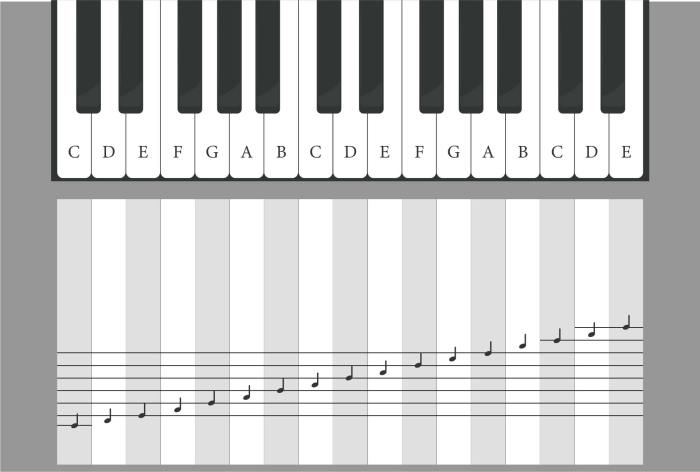
As you delve into the depths of this piano keyboard chart, you’ll not only master the technical aspects of piano playing but also cultivate a deeper appreciation for the instrument’s rich history and evolution. With each keystroke, you’ll trace the footsteps of musical giants, connecting with the timeless legacy of piano music.
Remember, the piano keyboard is not just a collection of keys; it’s a gateway to a world of endless musical possibilities, waiting to be unlocked by your curious fingers.
FAQ
What is the standard layout of a piano keyboard?
A standard piano keyboard consists of 88 keys, arranged in a repeating pattern of seven white keys and five black keys. The white keys represent the natural notes (C, D, E, F, G, A, B), while the black keys represent the sharps and flats (# and b).
How do I find the note names on the piano keyboard?
The note names on the piano keyboard follow a specific pattern. Starting from the leftmost white key, the notes ascend alphabetically from C to B. The black keys are named according to their position relative to the white keys. For example, the black key to the right of C is C#, and the black key to the left of D is Db.
What are key signatures, and how do they affect the notes I play?
Key signatures are musical symbols that indicate the sharps or flats that should be played throughout a piece of music. They are written at the beginning of the staff and apply to all notes of the corresponding pitch. For example, a key signature with one sharp (#) indicates that all F notes should be played as F#.
What is the difference between major and minor scales?
Major and minor scales are two fundamental types of musical scales. Major scales have a bright and cheerful sound, while minor scales have a darker and more somber sound. The difference between them lies in the arrangement of whole and half steps within the scale.
Why is proper fingering technique important for piano playing?
Proper fingering technique is essential for efficient and accurate piano playing. It helps you to distribute the weight of your fingers evenly, reduce tension, and improve your dexterity. By using the correct fingering, you can play faster, smoother, and with greater control.